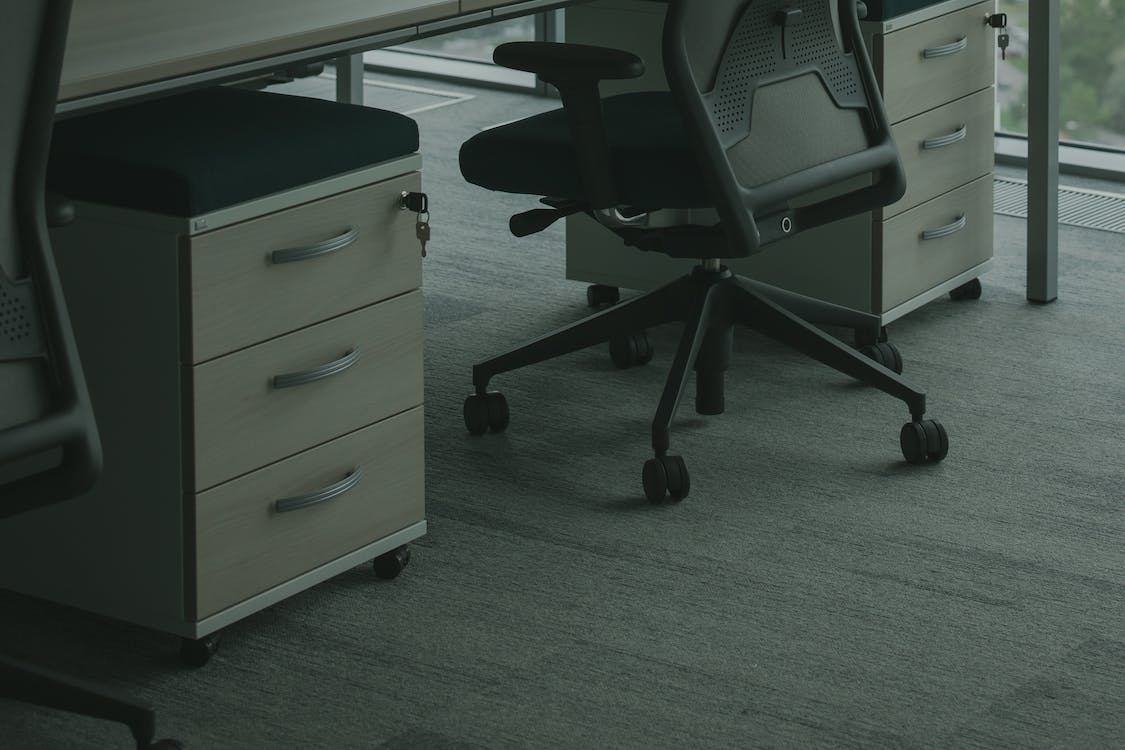How Do You Know If A Chair Is Ergonomic?

https://pixabay.com/photos/back-pain-shoulder-injury-sun-5163495/
In the busy corporate world, many employees have to sit for long periods at work. Prolonged sitting increases the risk of developing occupational health problems associated with bad postures, such as neck pain, stiff shoulders, upper and lower back pain, muscle tenderness, and numbness in the arms and legs.
Although prolonged sitting requires less muscular effort, it exposes you to high injury risk by putting a lot of strain on your upper and lower body. A person working in a sitting position will experience back pain, joint aches, bad circulation, and poor mental health. Additionally, it puts significant pressure on one's knee cap, which causes an achy feeling in the tendon. With the lack of proper support, more serious injuries, such as Patellofemoral.
Data entry operators, assembly-line workers, and clerks who spend long hours in a seated position experience health effects that prevent them from being productive and efficient.
Gamers who are often seen on a gaming chair, are not spared from such pain and injuries. Gaming spans significantly long hours, which might promote bad posture and place stress.
However, finding the right ergonomic office chair for you is challenging as there are many things to consider, such as the ergonomic chair features. For example, adjustable seat height. With that in mind, let's delve deeper into chair ergonomics to help you understand how it works and why it matters.
What is an ergonomic chair?

https://pixabay.com/photos/back-pain-body-pain-ergonomics-6949392/
Before we tap into the benefits of sitting on ergonomic chairs, let's briefly explain what ergonomics is. Ergonomics is the term used for the scientific study of employees' workplace efficiency.
It deals with the best, healthiest practices for improving productivity and efficiency by providing employees with chairs, tables, furniture, and equipment designed to complement office interactions between them. Ergonomic chairs are products of biotechnological or human engineering design that aim to provide the best support for the human body.
Since prolonged sitting prevents the human body from maintaining healthy functions, postural-related health problems and complaints are rising. That's where ergonomic office chairs come into the picture. They are vastly different from your typical office chair.

https://pixabay.com/photos/back-pain-spine-injury-backache-5248830/
Ergonomic chairs can benefit your health by providing fully adjustable and innovative lumbar and upper body support features. These chairs have everything that a regular office chair lacks for sitting posture support.
That's why modern employers are increasingly looking for the best ergonomic office chairs with adjustable features. Providing support for the entire body helps promote good posture by complementing the natural curve of the lumbar spine, allowing you to sit correctly.
Essential features of a good ergonomic chair

https://unsplash.com/photos/U6EXlQCZ938
The vital thing about ergonomic chairs is their proven ergonomic design that allows for the highest levels of adjustability. Since every person is unique in terms of body dimensions, body weight, and height, ergonomic chairs are highly adjustable to cater to different people and personal preferences.
No one sits in one position throughout the day, and sitting posture tends to vary depending on the situation and the type of office work a person performs. A good ergonomic chair must support the body regardless of the sitting position.
However, the level of support depends on the features that make up a good ergonomic chair. Here are the essential elements to look for in the best ergonomic office chair.
Adjustable lumbar support

https://pixabay.com/photos/lower-back-back-ache-lumbar-6391104/
The lumbar spine resides in your lower back area and is the most common source of pain for modern-day employees. That's why adjusting lumbar support is critical to maintaining good posture throughout the workplace.
There are three types of lumbar support:
-
Fixed lumbar support – focuses on the backrest to provide lower back support.
-
Adjustable lumbar support – allows you to adjust the lumbar support according to your firmness, depth, and height needs.
-
Dynamic lumbar support – automatically adjust the chair to your weight, height, and sitting posture.
Although many believe that dynamic or adjustable lumbar support can solve their posture problems, things aren't that simple. The amount of backrest tilt, flex, dimensions, and material all play a vital role in how comfortable and easily adjustable an ergonomic chair will be.
Since no person is the same, you should take some time to perform a test run on a chair before buying.
Adjustable seat height

https://unsplash.com/photos/KQ0C6WtEGlo
Adjustable seat height is paramount to avoiding back pain in the lower and upper body. The seat height should be easily adjustable to let you touch the floor firmly with both feet flat while positioning your knees at a 90-degree bent angle.
The fastest way to ascertain the optimal seat height for your ergonomic chair is to adjust it to bring the seat top below your kneecap.
Seat width

https://unsplash.com/photos/iJ1lw8iNIy8
The best ergonomic chairs should have a wide enough seat to cover all pressure points evenly and allow you to sit comfortably. The seat design should also support various adjustments to fit your seated position.
Seat depth

https://www.pexels.com/photo/black-rolling-chair-inside-the-office-5483052/
Seat depth depends on your height. An ideal seat depth should allow you to sit properly without feeling pressure in your legs, shoulders, back, or knees. It should also have a matching backrest to support your lower back, thighs, and buttocks.
Seat depth adjustment is an essential feature in an ergonomic chair because it allows blood circulation to the legs and avoids putting your knees under excessive pressure.
Adjustable armrests

https://www.pexels.com/photo/person-in-green-shirt-and-beige-pants-9065246/
A good ergonomic office chair should provide adjustable armrests to support your arms and take some of the load from your neck, back, shoulders, and legs in the seated position. The height of armrests should also be able to be adjusted.
It should allow you to adjust the armrests to the height of your desk so you can keep your arms parallel to your work surface. In addition to adjusting armrest height, look for chairs that are pivoting and width adjustable to provide more support for your elbows, shoulders, and forearms.
Backrest angle adjustment

https://unsplash.com/photos/oTidpdh24yQ
Top-grade ergonomic office chairs allow users to adjust the backrest angle to reduce pressure on the back, hips, and knees as they sit.
There are two ways to set the backrest angle – tilting and reclining.
Tilting
Tilting allows you to adjust the angle using a tilt and swivel mechanism. It ensures that the backrest changes angles in unison with the seat to allow you to lean back and stimulate micro-movements to your back to remove some of the strain buildups.
Reclining
The reclining mechanism allows you to adjust the backrest angle independently of the seat. It's an excellent way to get some rest during a busy day due to the more flexible angle adjustment.
In addition, we recommend opting for ergonomic chairs with height-adjustable backrests that support your upper back by complementing the natural curvature of your spine.
Adjustable headrest and neck support
Adjustable headrests in an ergonomic chair allow you to pivot inward and out to support your neck and prevent your head from tilting forward and disrupting your posture.
A height-adjustable headrest restricts upper back movement and conforms to the shape of your spine, preventing neck and back pain and shoulder stiffness.
Seat design and material

https://unsplash.com/photos/tjd5CfdDPRA
Many people aren't aware of the importance of seat design and material in a chair. Since it bears most of your weight, the seat should be supportive, breathable, and soft enough to make you sit comfortably.
According to DSE regulations, all ergonomic office chairs must have a five-star base to ensure safety and posture adjustment. A five-star design removes pressure on the lower back while allowing blood circulation to lower limbs and preventing fatigue.
When choosing an ergonomic chair, we recommend opting for mesh material as it's more durable, flexible, breathable, and easy to maintain.
Top reasons why every office needs ergonomic chairs
Ergonomic chairs allow employers to ensure their office workers remain healthy and productive. Here's our comprehensive list of why modern companies need the best ergonomic chairs.
Posture support
Since regular chairs lack essential ergonomics, they force you to lean forward when sitting for long, disrupting your natural posture. An ergonomic chair eliminates this problem by providing support that will help correct your posture.
Enhanced productivity
Your employees will be more productive if you provide them with ergonomic and comfortable office furniture. Instead of worrying about back pain, they'll be able to focus on their work, despite long sitting hours. Another
Fewer health problems
Office workers suffer neck and back pain, which impacts their state of mind and affects employee happiness. Unhappy workers will hardly be productive. However, ergonomic office furniture promises fewer back pain problems and better relaxation, leading to a more productive workplace.
Adjustability
Office chairs and furniture should be flexible enough to match the unique needs of each employee in your company. Each individual has a different body weight and dimensions.
The most effective way to meet such diverse requirements is to invest in adjustable furniture that your employees can personalize according to their sitting positions.
That's why you should invest in high-end ergonomic chairs with adjustable armrests, headrests, backrests, seat width, height, and depth.
Fewer claims and reduced absenteeism
Many employers face increased employee absenteeism due to problems associated with prolonged sitting. They also have to set aside a budget to mitigate medical expenses for absent workers.
However, you can reduce absenteeism rates and pay less for medical insurance for your employees by investing in ergonomic office furniture. Since ergonomics can improve their health, your employees will have more time on their hands to focus on the core mission instead of struggling with health problems such as neck and back pain.
Aside from creating a healthier workforce and happier work environment, relaxed employees will give their 100% to meet company goals. Investing in office ergonomics is a long-term investment that can help you avoid worker compensation claims and establish a positive company culture in a thriving employee community.
Optimum safety
Aside from saving resources and increasing employee satisfaction, ergonomic office furniture improves the safety of your workers.
Ergonomic chairs have to pass thorough lab testing and receive the necessary certifications to guarantee the optimum safety of the users.
Conclusion
An ergonomic chair must include essential features to be safe, highly comfortable, and flexible enough to support prolonged sitting in various positions. Ergonomic features are at the core of every cutting-edge chair and should include an adjustable headrest, armrests, backrest, seat height, width, and depth.
However, even with all these features at your side, it'll still take time and testing to find a chair that matches your exact needs. Thankfully, the top chair manufacturers offer test runs for clients to allow them to make an informed purchasing decision.
So, after all this, you will probably have no difficulty telling whether a particular chair is ergonomic.


